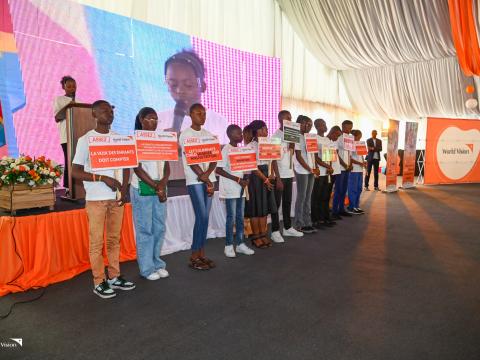World Vision Launches Campaign to Combat Hunger and Malnutrition in the Democratic Republic of Congo

By World Vision DRC
- Children under the age of 5, both girls and boys, are the most vulnerable to hunger and malnutrition, especially those living in the fragile context of armed, ethnic and land conflicts and population movements.
- The mortality rate for children under the age of 5 in the DRC for the 5 years is 70 per 1000. In other words, 7 out of 100 children die before reaching their 5th birthday.
- According to the document review carried out by World Vision's team of health and nutrition specialists based on data available to date, stunting remains a major public health problem in the DRC, with all provinces having a threshold of over 30%.
- Global acute malnutrition (GAM) is 8.2% [7.5-9.0] with 2.6% [2.2-3.1] of children suffering from the severe form (SAM). The prevalence of GAM at national level is below the high threshold (>10%) according to the WHO classification. The prevalence of chronic malnutrition is 47.9% [46.2-49.7] nationally, exceeding the very high threshold (>=30%) according to the WHO classification. Nearly one child in two suffers from stunted growth in the DRC. The prevalence of overweight at national level is 2.7%, with 0.5% obese. Among children under 5, the specific mortality rate is 0.73 deaths per 10,000 children per day, which is below the alert threshold of 2 deaths per 10,000 children under 5.
- According to the 2023 National Nutrition Surveys, it is estimated that nearly 25.4 million people are food insecure, while acute malnutrition affects 8.4 million people, mainly children under 5, pregnant women and nursing mothers. The stunting rate in the DRC (42% of children under the age of five) is one of the highest in sub-Saharan Africa, and malnutrition is the underlying cause of almost half the deaths in this age group. Unlike other African countries, the prevalence of stunting in the DRC has not decreased over the last twenty years. In addition, the DRC is ranked among the ten countries that account for 60% of the global burden of wasting in children under 5. Furthermore, the 2023 Global Hunger Index (GHI) ranks the DRC 122nd out of 125 countries, and in an alarming situation. As well as stunting children's physical growth, chronic malnutrition affects their cognitive and intellectual development, reducing their performance at school and their productivity in adulthood.
- These results argue in favour of strengthening the promotion and protection of optimal infant and young child feeding practices throughout the 1,000-day life cycle (from pregnancy to two years of age).
Kinshasa, September 17th, 2024 - World Vision is proud to announce the launch of its new campaign, the ENOUGH Campaign, aimed at addressing the hunger and malnutrition crisis in the Democratic Republic of Congo (DRC). The campaign comes in response to alarming reports that some regions of the DRC have reached a high level of malnutrition.
The ENOUGH Campaign seeks to mobilize resources, engage local and international stakeholders, and implement effective strategies to provide immediate relief and long-term solutions to those suffering from extreme hunger and malnutrition. This initiative builds on our commitment to ensure that no child in the DRC faces the devastating impacts of food insecurity.
Key Objectives of the ENOUGH Campaign:
1. Emergency Food Assistance: Deploying immediate aid to affected areas to alleviate hunger and provide life-saving nutrition to the most vulnerable populations, including children and pregnant women.
2. Sustainable Agriculture Programs: Supporting local farmers with training, resources, and technology to enhance food production and resilience against future crises.
3. Healthcare and Nutritional Support: Providing essential health services, including treatment for malnutrition and support for health facilities overwhelmed by the crisis.
4. Advocacy and Awareness: Raising global awareness about the crisis in the DRC and advocating for greater financial support and prioritization from governments, NGOs, and the international community.
5. Community Engagement: Collaborating with local communities to develop culturally appropriate solutions and empower them to take charge of their food security.
“The aim of the ‘ENOUGH’ campaign is to mobilise even more players around the issue and also to mobilise even more resources to put an end to this crisis, the national scale of which is staggering, with more than one (1) million children (41.8%) under the age of 5 affected by stunting, a rate higher than the average for the African region (30.7%). I welcome the government's commitment to this issue and to school canteens. We need to pull together and take immediate action. The challenge of child hunger and malnutrition is not beyond us. We have enough to put an end to this crisis”, says Aline Napon, National Director of World Vision DRC.
Thus, World Vision invites, partners, medias, and the national community to participate in and support the ENOUGH Campaign. Together, we can make a difference and work towards ending the crisis that has plagued the DRC for too long.
ENDS
For more information about the ENOUGH Campaign and how you can get involved, please visit www.wvi.org/enough or contact Farida Eliaka, Advocacy, Communications & EE Director at +243 970 001 079 or Farida_Eliaka@wvi.org
World Vision is a Christian, child-focused organization that was established in 1950 and has been operational in DRC since 1988. Last year, World Vision reached 1.8 million vulnerable children in DRC through its programs.